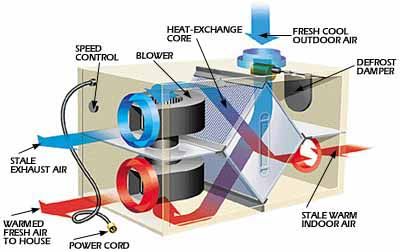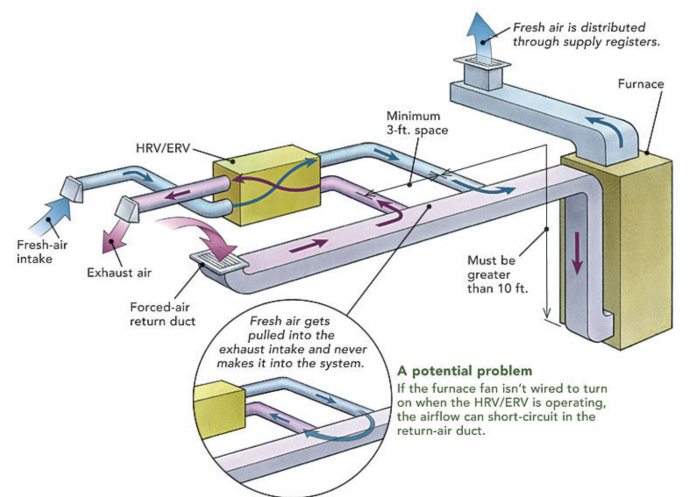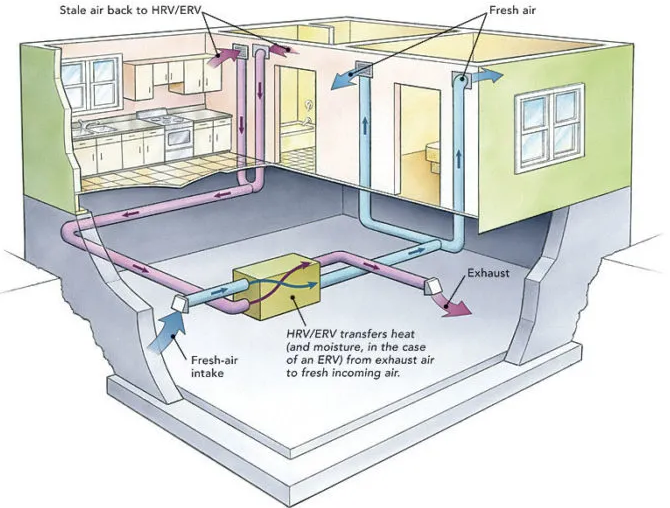Today, HRV vs ERV is a controversial subject in the ventilation technologies. A new sealed home requires mechanical ventilation. The main options are Energy Recovery Ventilation (ERV) or Heat Recovery Ventilation (HRV) and this post clarifies the contrast between an HRV & ERV to help select which one you require. All buildings need ventilation, whether mechanical or natural with an HRV or ERV system. Homes are no longer made leaking heat and humid air the way they utilized to be; we now make them as sealed as we can. This forces us to employ mechanical ventilation systems in these high-procedure homes by setting either HRV or ERV Systems.
Why Do We Use Ventilation Systems?
How much fresh air is needed in buildings and the best solution to supply it are considerable issues. Energy restoration from external air is becoming a prevalent method in cold regions, and two kinds of systems can operate this – an ERV (Energy Recovery Ventilation) and an HRV (Heat Recovery Ventilation).

Both HRVs and ERVs are modern to the basic home structure. In an effort to clarify that, we will primarily illustrate why ventilation is so important, then present the choices and their best applications.
Up to the recent decades, buildings were too leaking to air entering that enough cold and dry air came in to meet the requirements of occupants, and certify that homes had no humidity hurt. These homes were introduced as “breath mechanisms”, but that is similar to breathing through the skin instead of your nose. In a cold climate area, it meant that dry, cold winter air would require to be heated as well as humidified having found its way into a house.
Presently, in the process of energy efficiency, buildings are constructed to more standards of air sealing and building construction methods all over the world is being updated to satisfy this, so mechanical ventilation systems are important to keep healthy internal air quality on.
Brief Definition of Heat and Energy Recovery Ventilation
Recovery Ventilation in buildings or offices has two main types which are utilized more than the other systems. These useful types are introduced as following.
Heat Recovery Ventilation
Heat Recovery Ventilation (HRV) is a system that utilizes the heat in old external air to preheat entering new air. It decreases the energy needed to bring up outside air to the room temperature so preserves money on heating costs and bills. Like the human breathing operation as presented above, this exchange of air is done in a single location of the home. It seems that the lung of your home is the HRV ventilator core.
Note that exhausted old air and entering fresh air never mix in the heat recovery procedure; they easily move in separate channels in the ventilator center, the heat exchanger, permitting a transfer of heat through conduction. The ‘efficiency rate’ of an HRV part specifies how much energy will be preserved by employing that specific device. Although it needs work of a fan on a ceaseless basis, the energy regained from the inside air is many times that of the energy needed for the fan.
Usual efficiencies differ from 55% to 75%, but some efficient designs are estimated as high as 93% efficiency. However, these latter devices are remarkably more expensive. Nevertheless, when you evaluate the value of energy preserving over the unit’s full life cycle, it would be obvious that it is still a financially and ecologically sound investment.

Energy Recovery Ventilation
Energy Recovery Ventilation (ERV) is more complex than the HRV ones, as this model also catches some of the moisture in the air. Therefore, in cold winter climates, an ERV system moves the moisture from the exhausted air to the entering new and dry air to help maintain the indoor moisture rate at a reasonable value (between 40 and 60%).
In summer, the moisture movement in an ERV saves and the humidity in external air is eliminated before it is entered into the home. This preserves energy by decreasing the load on air conditioning devices. The high efficiency of moving moisture would be around 70%, but this evaluation is influenced by the practical moisture on either side of the system.
One noticeable matter is that whatever you select for your requirements between an ERV & HRV, there will usually be a power on/off switch. If your device is too noisy, you will probably turn it off for long periods of time even if you require it. Selecting a quiet ERV or HRV system and ensuring that it is installed appropriately represents both a financial and health investment.
What HRVs and ERVs do
The two kinds of system have the following operations in common:
- Evacuation: ERVs and HRVs bring out pollutants suspended in the house’s inner air along with extra moisture.
- Fresh air: They rotate the air inside the home every three hours: when the cycle is complete, an equal amount of new air will have replaced what has been exhausted.
- Filtration: Both ventilators are developed with a filter that restricted ingress of contamination, pollen, and insects.
- Distribution: HRVs and ERVs are joint with some ductwork to all rooms in the home. In particular cases, they may be combined with an existing heating system.
- Heat recovery: Most common versions of both types of ventilation units have a core in which the internal and external air passes without actually touching, according to the separating walls. These dividers, constructed of aluminum or polypropylene, are sealing air but can move sensible heat. Therefore, in winter some of the heat exiting the device is moved to the entering air. This heat recovery can be introduced as energy savings.
Basic difference between Them; HRV vs ERV
The main difference between HRV and ERV systems is in their center unit. Whereas an HRV’s heat recovery core’s separating wall are moisture-sealed, those in an ERV are different: they consist of a desiccant substance (which absorbs some of the moisture).
The ERV conveys moisture from the more humid airstream to the least moist stream. In winter, when moisture rates are typically higher in the home than outside, the ERV dries exhausted air and damps entering the air. It can be said that during the cold months, an ERV keeps more moisture in the home than an HRV.
ERV or HRV – Which Ventilation System to Choose?
The best choice between an ERV and an HRV relies on the climate and particular requirements. If your home is too moist in winter (more than 60%) then an HRV is the better option, as it would undoubtedly get rid of extra moisture while an ERV would be inclined to keep it high. Visit here to explore more about them.
Otherwise, if your home is too dry in winter, then an ERV would be an effective option as it helps maintain moisture, removing the requirement and cost for producing it through other methods.
In the summertime, the utilization of an HRV will normally raise the moisture rate inside your building, so an ERV is more effective in hot and humid zones. But a separate dehumidifier will probably run this method much better. The ERV will reduce the cost of the air conditioning system, even if it can’t combine with the high moisture rate on the outside.
So, finally, there is no one right option between ERV & HRV systems. It is based on the climate, your lifestyle, the specific application, and your building.
What about Summer and Air Conditioning?
Unlike HRVs, an ERV can help the dehumidification procedure of air conditioner in homes by moving some of the moisture from entering air to exhausting air in summer. This is considerable in warmer climates, but in cold locations like Quebec in North America, the option between HRV and ERV systems should rely on winter conditions.
Making your Choice between Ventilation Systems
The option between ERV and HRV units is based, in large part, on the moisture rates in the home—but the important following issues should also be noticed to choose a ventilation system:
- The number of occupants in the building: An HRV matches the requirements of a larger, energetic family that produces a lot of moisture. On the other hand, the fewer occupants in the house, the drier the air will be, in which instance the ERV is a more effective option than other ventilation systems.
- Dimensions: Generally, HRV systems are best fitted to medium or small-sized houses, where moisture can rapidly cumulate. ERVs, conversely, will better service larger buildings where the air be inclined to be drier.
- Sealing of the building: The better the walls and windows are sealed, the more moisture remains in, so choosing the HRV will be more reasonable.
- Method of heating: In a wood-heated home, which is more probable to be drier, an ERV will provide a healthier moisture rate than other ventilation systems.
- Topographical climate: Another specifying issue is that ERVs are the most suitable for drier, colder climates like those of Quebec City in North America, for example. HRVs operate more effectively in the mediocre winters which are more humid like in Montreal city.
Performance and installation of Ventilation Systems
If you are ready to select between HRV and ERV systems, you should look for a model and design whose process has been confirmed by recovery ventilation rates and meets the efficiency regulations of the energy programs in your country. HRV and ERV systems must pass a sensible heat-recovery efficiency (SRE) level of at least 60% at -25 degrees Celsius and at least 65% at 0 degrees Celsius to be certified the standards of energy efficiency.

Eventually, you should not assign the responsibility for the installation of new systems to the first proposer. This is owing to the fact that both HRV and ERV systems require to be appropriately calibrated to balance entered and exhausted airstream. Briefly, just a qualified recovery ventilation operator must be employed to install a ventilation system in your home after choosing the suitable type between HRVs or ERVs.



